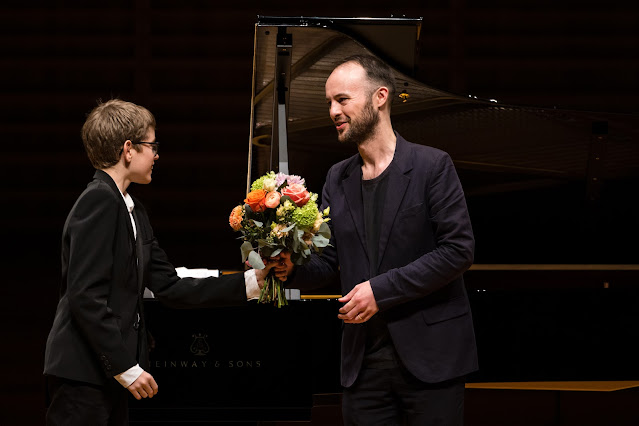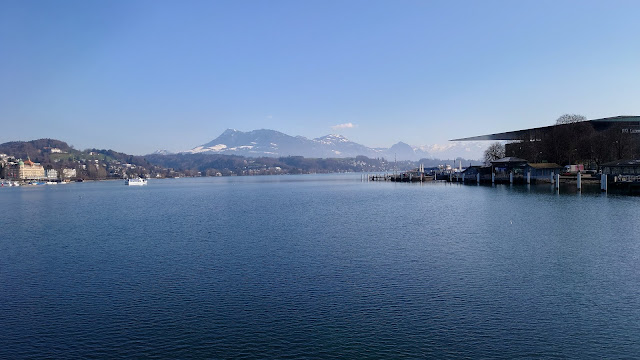 |
| Paderewski: Piano Concerto - Yoav Levanon, Lucerne Symphony Orchestra - Le Piano Symphonique, KKL Luzern (Photo: Philipp Schmidli) |
Paderewski: Piano Concerto, Glass, Galuppi, Cimarosa, Mozart, Edmund Finnis: Mirror Images; Yoav Levanon, Lucerne Symphony Orchestra, Michael Sanderling, Víkingur Ólafsson; Le piano symphonique at KKL Luzern
Reviewed 9 February 2023
A daring contrast, beginning with the young pianist Yoav Levanon in devastating form in Paderewski's Piano Concerto and ending with Víkingur Ólafsson in Edmund Finnis' seductive sequence, Mirror Images
For the evening concerto on Thursday 8 February in the Konzertsaal of KKL Luzern, the Lucerne Symphony Orchestra's festival, Le piano symphonique presented an intriguing double bill. For the first half, pianist Yoav Levanon joined the Lucerne Symphony Orchestra and conductor Michael Sanderling for Paderewski's Piano Concerto. After the interview, the stage had cleared and pianist Víkingur Ólafsson gave a solo piano recital mixing Philip Glass, Galuppi, Cimarosa and Mozart, ending with Edmund Finnis' Mirror Images.
The resulting evening was a daring experiment and the two halves were in complete contrast. The music chosen by Ólafsson, with its sense of control, subtle use of colour and gentle modulation of tone, contrasted brilliantly with the elaborations of Paderewski's writing where, if there was a melody, the composer would decorate it.
 |
| Víkingur Ólafsson - Le Piano Symphonique, KKL Luzern (Photo: Philipp Schmidli) |
Paderewski has a strong Swiss connection. In the 1890s he bought a villa in Morges which from then on he used as a rest haven between tours, and in the 1920s and 1930s it became a political base as he involved himself in the politics of the independent Poland created after World War I.
Paderewski was in his 20s when he wrote his Piano Concerto (during the 1880s) for himself to play. His friend Saint-Saens regarded the work with approbation. Like Bruch's Violin Concerto No. 1 (from 1866), the wok mixes a rather backward-looking structure with elements of modern harmony and plenty of bravura. Like the Schumann and Chopin concertos, Paderewski provided plenty of space for the pianist, the solo responses to the orchestral tuttis were often unaccompanied and nearly so.
The work opened with an orchestral introduction that seemed to almost presage an operetta, but the piano took this material in a different direction with poetic simplicity developing into real bravura. Levanon's performance was devastating, playing from memory he made all the roulades seem poetic, effortless and natural. The slow movement was based around an elegantly expressive theme and at first things were of great simplicity, but Paderewski's instinct to decorate came to the fore, and decorate he did. The finale returned to the world of opera comique, but this time the piano joined in, creating music of vivacious character and real bravura.
Yoav Levanon played to the manner born. He is only 18, he has the technique necessary for the work alongside a sense of real musicality so he brought out the poetry of the music rather than simply barnstorming. There was something deftly understated about his performance that drew you in. Sanderling and the orchestra were in strong form, but though Paderewski gave them real opportunities, all ears were on Yoav Levanon.
The audience's reaction to the performance was thunderous and we were treated to two pieces of Liszt as encores, though I was half hoping for Paderewski's Minuet!
What to follow the Paderewski with?
Le piano symphonique's solution was to provide a sort of aural sorbet or palate cleanser after the richness of the concerto. The Icelandic pianist Víkingur Ólafsson played a sequence of short movements centred around the music of Philip Glass and ending with the Swiss premiere of Edmund Finnis' Mirror Images. Ólafsson's sequence began with the opening from Glass' Glassworks and Glass' Etudes nos. 2, 3, 5 and 6 were spread throughout the sequence, into these were inserted the first movement of Galuppi's Sonata No. 9 in F major, the first movement of Mozart's Sonata No. 16 in C minor K545 and Cimarosa's Sonata No. 55 in A minor in the pianist's own arrangement.
The Glass pieces were based around the idea of a rocking alternation of chords, slow maybe or fast, hypnotic, beautifully controlled and with subtle variations of tone and rhythm providing the emotional subtlety. The fascination was how these elements were common to the music such as the Galuppi and Cimarosa sonatas. The Mozart made a devastating moment of clarity, pellucid and refreshing. The penultimate Glass Etude seemed to be alarmingly akin to Rameau's Le rappel des oiseaux, whilst the final one evaporated in a devastating manner. This was one of those musical sequences that worked whilst you were never quite sure why!
 |
| Edmund Finnis after the Swiss premiere of his Mirror Images - Le Piano Symphonique, KKL Luzern (Photo: Philipp Schmidli) |
Edmund Finnis wrote Mirror Images for Ólafsson in 2021 and the pianist premiered the work at the Southbank Centre in 2022. This was only the work's second performance. Nine short movements (the total running time around 20 minutes), each one was titled simply with a direction, 'Steady, quietly expressive', 'Calm, reflective, very flexible'.
Each one was a perfectly crafted miniature, with a different presentation of a particular texture. Finely judged and beautifully refined, each one contrasted with the other movements. References to the earlier sequence of pieces could be detected, Philip Glass seemed the godfather of one or two movements, whilst another seemed like Scarlatti on acid, and the final movement 'Flowing' combined the two. Finnis knew just when to stop, each piece a perfect miniature yet the whole creating a seductive sequence.Many thanks to the Lucerne Symphony Orchestra in taking me to Lucerne, and thankfully my return journey was painless!
 |
| KKL Luzern with the lake and the mountains |
Never miss out on future posts by following us
The blog is free, but I'd be delighted if you were to show your appreciation by buying me a coffee.
Elsewhere on this blog
- New music should not be seen as extra-terrestrial, it should not generate fear: I chat to composer Ana Sokolovic, artistic director of the Société de musique contemporaine du Québec - interview
- Fluidity and intimacy: Martha Argerich in Schumann's Piano Concerto at Le Piano Symphonique festival in Lucerne - concert review
- Unexpected creativity: cellist Margaret Maria and soprano Donna Brown talk about the joys of collaboration on the words and music of their album Between Worlds - interview
- Galina Grigorjeva: Music for Male-Voice Choir - record review
- Peter Grimes in Paris: a powerful performance from Allan Clayton as he leads the Paris revival of Deborah Warner's striking production - opera review
- A virtuosic cascade of ecstatic and endless deep listening: The Hermes Experiment with Shiva Feshareki - concert review
- Part of her musical journey: violinist Esther Yoo chats about recording the Barber and Bruch concertos - interview
- Mangling Médée: why are stylistically appropriate performances of Cherubini's opera so rare? - feature
- Faces in the Mist: the first disc devoted to Richard Peat's striking and evocative music - record review
- Lyricism, melancholy & sadness: pianist Ruth McGinley & composer Neil Martin collaborate on Aura - record review
- Style and elegance: with Bach-Abel Society, Les Ombres take us back to the elegant evenings of the Bach-Abel concerts in 18th-century London - record review
- Home



%20and%20kids.jpg)
.webp)




.jpg)

No comments:
Post a Comment